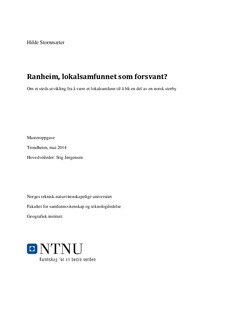| dc.description.abstract | In this thesis I have studied a particular place located east in Trondheim, Norway. This place, called Ranheim, has experienced a tremendous development. Form being a small independent local community to gradually become a bigger part of the city Trondheim. My focus has been on how this development has affected Ranheim as a place and the perception of it.
I have tried to briefly present an overview of philosophical approaches to place and its history, in geography. I have used different theoretical approaches to place; place as location, sense of place and place as locale (Agnew 1987) combined with newer approaches to place. I have also applied theory on place identity, place attachment, local communities and living environment, which I hope will provide a solid theoretical foundation for my discussion.
I have utilized different qualitative approaches to collect my empirical data material, including interviews and focus groups; five key informants, who represent a great diversity of information about Ranheim and two focus groups, who have consisted of residents of the area. One group contained four people who have lived in the area for over ten years and the other group of four people who recently moved there or who have lived there for three years or under.
The role of the factory as a cornerstone in the community has been reduced and therefore it does not contribute to a ‘common ground’ among the population. This can create challenges for the social environment in Ranheim, especially when the population within ten to fifteen years most likely will be doubled. The mental picture of Ranheim being separated from Trondheim can change when the physical space between Ranheim and Trondheim will consist of housing or other infrastructure instead of greenery and agricultural land. It will most likely then be seen as a part of Trondheim.
The new residents of Ranheim are younger and better educated compared to the wellestablished. The well-established show greater sign of a stronger place attachment, but it is not unlikely that the new inhabitants will experience part of the same strength in their place attachment in ten years or so. With the new residents and a development that seemingly makes Ranheim more alike other parts of Trondheim also comes the change in place identity.
The limitations have been lack of time as well as the use of only a qualitative method. A deeper and broader insight could have been achieved with the combination of both a quantitative as well as a qualitative approach. | nb_NO |
